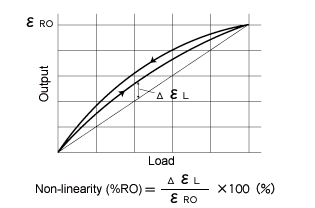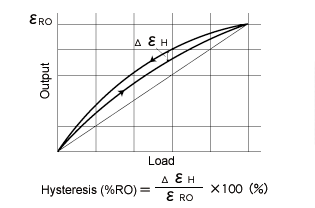- Capacity
- Maximum load that a transducer can measure and still maintain specifications
- Rated Output = RO
- Output at the rated load minus output under no-load conditions. Rated output is expressed per volt applied to the transducer (mV/V).
- Non-linearity
- Maximum difference of the transducer's output from a line connecting the calibration curve origin and the rated load point with increasing loads. Non-linearity is expressed as a percentage of rated output (%RO).

- Hysteresis
- Maximum difference between transducer output with increasing and decreasing loads. Hysteresis is expressed as a percentage of rated output (%RO).

- Repeatability
- Maximum difference in output when the same rated load is measured repeatedly under identical load and environmental conditions. Repeatability is expressed as a percentage of rated output (%RO).
- Temperature Effect on Zero
- Transducer output due to changes in ambient temperature. Temperature effect on zero expresses change per degree of ambient temperature as a percentage of rated output (%RO/℃).
- Temperature Effect on Span
- Rate of change in load output due to changes in ambient temperature. Temperature effect on span is expressed per degree of ambient temperature (%/℃).
- Compensated Temperature Range
- Range of temperatures compensated for temperature effect on zero and span. (℃).
- Temperature Range
- Range of temperatures that can be applied continuously without causing permanent destructive change to the transducer (℃).
- Overload
- Load that can be applied continuously without causing permanent change exceeding specifications (%).
- Ultimate Overload Rating
- Maximum load that can be applied continuously without causing permanent destructive change mechanically (%).
- Recommended Exciting Voltage
- Voltage that can be applied to the transducer and still maintain the specifications (V).
- Allowable Exciting Voltage
- Maximum voltage that can be applied continuously to the transducer without causing permanent destructive damage (V).
- Zero balance
- Output strain while unloaded (x10-6 strain)
- Frequency Response
- Maximum frequency at which the transducer can output within a specified range using a sine wave load (Hz).
- Natural Frequency
- Frequency under no-load conditions at which a transducer oscillates freely (Hz).
- Allowable Bending Moment
- Maximum bending moment that can be applied continuously to the transducer without causing permananet destructive damage (kN·m).
- Sensitivity
- Transducer output with a fixed load. Sensitivity expresses strainmeter output per millimeter (x 10-6 strain/mm) when the strainmeter coefficient on the displacement transducer is set at 1.000 (2.00 gauge factor fixed).
- Gauge Length
- Distance between two points used to measure displacement or strain.
- Spring Force
- Approximate force required to displace capacity on the displacement tansducer (N).
- Input / Output Resistance
- Resistance between input and output terminals measured under no-load conditions with input and output terminals disconnected (Ω).
- Input / Output Cable
- Cable that cannot be disconnected from the transducer.
- Supplied Cable
- Standard cable accessory that can be disconnected from the transducer.
- Weight
- Approximate weight of the main unit minus I/O cable and cable accessories.(g,kg)
- About IP ratings
- A classification system rates how well enclosures and package for electrical components seal against intrusion by foreign materials such as dust and moisture. It conforms to JIS C 0902, or IEC 60529, and entails various levels of ingress protection afforded against solid objects and water.
More Information


